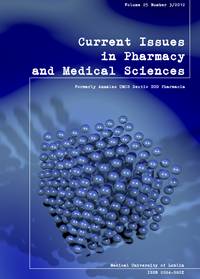Osteocalcin and selected biochemical parameters of bone turnover in healthy subjects
DOI:
https://doi.org/10.12923/j.2084-980X/25.3/a.25Słowa kluczowe:
osteocalcin (OC), bone turnover, age, genderAbstrakt
Osteocalcin (OC) is non-collagenous bone matrix protein produced by osteoblasts. OC binds to hydroxyapatite and is deposited in the bone matrix. Concentration of OC in the blood seems to reflect both osteogenesis and increased bone metabolism and depends on age, sex, menopausal status. The aim of our study was to evaluate changes in the concentration of osteocalcin and selected biochemical parameters of bone turnover in different stages of life in healthy people. We found that the mean serum levels of OC were significantly greater in women than in men. The highest OC levels were found in men under the age of 30 with a decrease in the fourth decade of life. In the group of women of up to 40 years of age, OC concentrations were comparable with the equivalent group of men. The lowest concentration of OC was found in the age group 40-49, with the significant increase in the subsequent decades of life. In both men and women, we found a significant correlation of OC with the calcium concentrations and alkaline phosphatase activity. Osteocalcin determinationa, particulary in women, may be useful laboratory parameters of osteoporosis process.
Bibliografia
1. Ambroszkiewicz J., Gajewska J., Laskowska-Klita T.: Kostna frakcja fosfatazy alkalicznej; charakterystyka i przydatność kliniczna jej oznaczania. Med. Wieku Rozw., 6, 99, 2002.
2. Ambroszkiewicz J., Gajewska J., Laskowska-Klita T.: Osteokalcyna i kostna frakcja fosfatazy alkalicznej w surowicy krwi dzieci zdrowych w zależności od wieku i płci. Med. Wieku Rozw., 3, 257, 2002.
3. Calvo M.S., Eyre D.R., Gundberg C.M.: Molecular basis and clinical application of biological markers of bone turnover. Endocrine Rev., 17, 333, 1996.
4. Chenu C. et al.: Osteocalcin induces chemotaxis, secretion of matrix proteins, and calcium- mediated itracellular signalig in human osteoclast-like cells. J. Cell. Biol.,127,1149, 1994.
5. Delmas P. D.: Biological markers of bone turnover. J. Bone Miner. Res., 2, 549, 1993.
6. Delmas P.D.: Biochemical marker of bone turnover for the clinical assesment of metabolic disease. Endocrinol. Metab. Clin. North Am., 19, 1, 1990.
7. Dziedzic-Gosławska A.: Modelowanie strukturalne i przebudowa wewnętrzna tkanki kostnej. Klinika, 5, 3, 1994.
8. Dziedziejko V., Safronow K., Machoy-Mokrzyńska A.: Wartość diagnostyczna i kliniczna oznaczania aktywności izoform fosfatazy alkalicznej. Diagn. Lab., 36, 505, 2000.
9. Fedak D.: Laboratoryjne markery zaburzeń metabolizmu kości. Badanie i Diagnoza, 5, 20, 1999.
10. Fedak D.: Metabolizm kostny. Badanie i Diagnoza, 14, 81, 2008.
11. Fedak D.: Diagnostyka chorób metabolicznych tkanki kostnej. Badanie i Diagnoza, 14, 85, 2008.
12. Fedak D., Anyszek T., Korkosz M. (2005). Diagnostyka laboratoryjna zaburzeń metabolizmu kostnego. In: Diagnostyka laboratoryjna z elementami biochemii klinicznej. Dembińska-Kieć A., Naskalski J.W. (editors).Wrocław: Urban & Partner; p.271.
13. Gajewska J., Ambroszkiewicz J., Laskowska-Klita T.: Biochemiczne markery obrotu kostnego i ich zastosowanie. Med. Wieku Rozw., 3, 421, 1999.
14. Gajewska J., Ambroszkiewicz J., Laskowska-Klita J.: Wybrane markery obrotu kostnego w surowicy krwi w zależności od wieku i płci. Wiad. Lek., 58, 476, 2005.
15. Griffiths J.: An alternate origin for the placental isoenzyme of alkaline phosphatase. Arch. Pathol. Lab. Med., 116, 1019, 1992.
16. Jancewicz P. et al.: Reprezentatywne wskaźniki resorpcji i tworzenia kości u zdrowych kobiet. Post. Osteoartrol., 10, 5, 1998.
17. Jilka R.L. et al.: Linkage of decreased bone mass with impaired osteoblastogenesis in a murine model of accelerated senescence. J. Clin. Invest., 97, 1732, 1996.
18. Karczmarewicz E. (2004). Biochemiczne markery obrotu kostnego. Poradnik dla lekarzy. In: Osteoporoza. Poradnik dla lekarzy. Lorenc S., Olszyński W.P. (editors). Warszawa: Biuro Gamma; p.424.
19. Kaczmarkiewicz E. (2000). Wartość diagnostyczna markerów obrotu kostnego- uzgodnienia 2000. In: Diagnostyka osteoporozy. Lorenc R.S. (editor). Warszawa: Osteoforum; p. 233.
20. Kiryłów E., Kamiński G.: Miejsce biochemicznych markerów obrotu kostnego w zaleceniach diagnostyczno-leczniczych osteoporozy. Pol. Merk. Lek., 25, 384, 2008.
21. Korczowska I., Łącki J.K.: Zastosowanie markerów biochemicznych w diagnostyce osteoporozy. Post. Nauk Med., 5, 68, 1998.
22. Lepage O.M. et al.: Circadian rythms of osteocalcin in equine serum. Correlation with alkaline phosphatase, calcium, phosphate and total protein levels. Can. J. Vet. Res., 55, 5, 1991.
23. Lian J.B., Gundberg C.M.: Osteocalcin. Biochemical considerations and clinical applications. Clin. Orthop. Relat. Res., 226, 267, 1988.
24. Marowska J. (1998). Markery biochemiczne w ocenie obrotu metabolicznego kości. In: Diagnostyka osteoporozy. Lorenc R.S. (editor). Warszawa: Springer PWN; p.118.
25. Partyka R. et al.: Biochemiczne wskaźniki przebudowy kości. Diagnostyka Laboratoryjna, 44, 269, 2008.
26. Riggs B. L.: Are biochemical markers for bone turnover clinically useful for monitoring therapy in individual osteoporotic patients? Bone, 26, 551, 2000.
27. Solnica B.: Zaburzenia metabolizmu kości. Badanie i Diagnoza, 5, 17, 1999.
28. Vergnaud P. Garnero P., Meunier P.J. et al.: Undercarboxylated osteocalcin measured with a specific immunoassay predicts hip fracture in elderly women. J. Clin. Endocrinol. Metab., 82, 719, 1997.
Pobrania
Opublikowane
Numer
Dział
Licencja
Prawa autorskie (c) 2012 Autorzy

Praca jest udostępniana na licencji Creative Commons Attribution-NonCommercial-NoDerivatives 3.0 Unported License.


